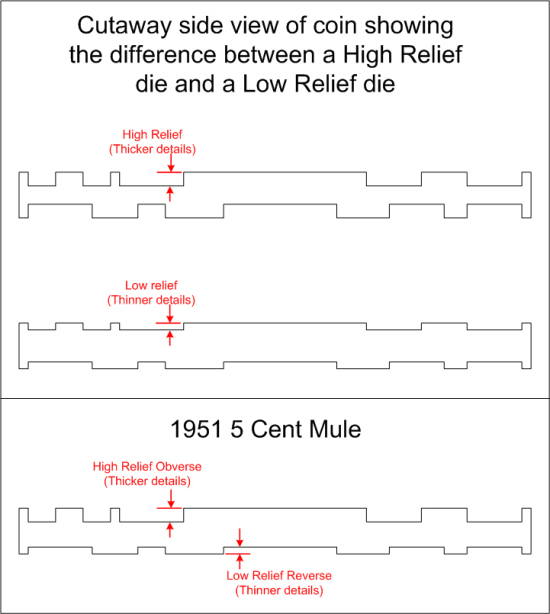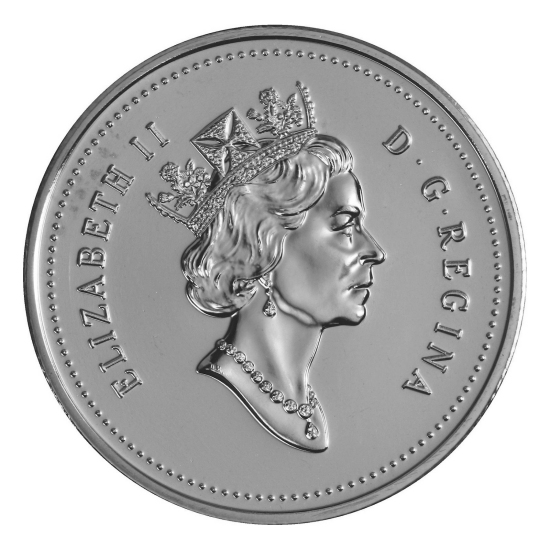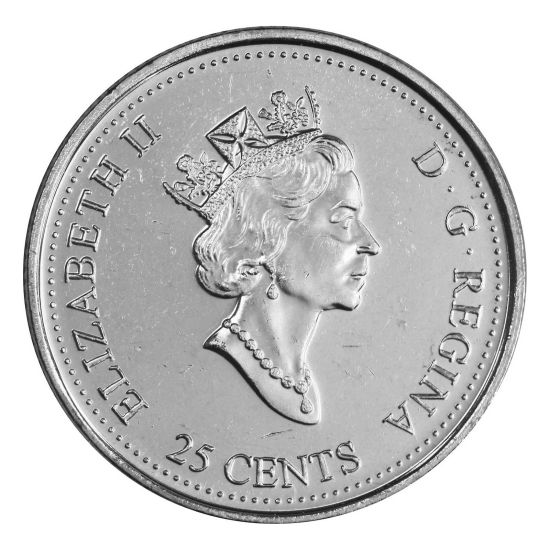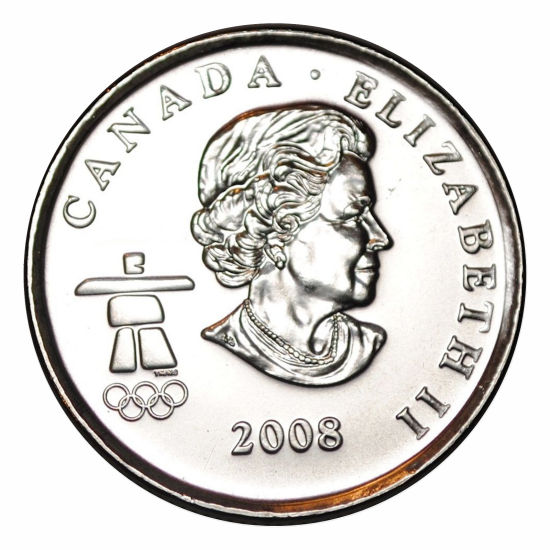Canadian "Mule" Coins
Preface
|
A "Mule" coin is defined as a coin where an incorrect die was used to strike either the obverse or reverse. A "Packaging Error" is typically a set of coins that was produced using the wrong denomination or year of one or more coins. Because of the risk of counterfeiting, the only recognized packaging errors are in sets which use a tamper-proof method of encapsulating the entire group of coins (for example an uncirculated or proof-like coin set which is encapsulated in pliofilm). Note there are two subsets of mule coins as well: - A "Handsome Mule" exists when one or both dies reserved for the production of Proof or Specimen quality coins is used to produce circulation (business strike) coins. (See the 1999 Nunavut $2 Mule below for an example) - A "Reverse Handsome Mule" exists when a circulation (business strike) die is used on Proof or Specimen coins (see the 2010 Specimen 10 Cent Mule below for an example). Note: Orientation errors, die cracks, worn dies and multiple-strike coins are not classified as mule coins, but are considered quality control errors.
NOTE: Click on any photo to load a much larger version of the same photo. |
Part 1 - "Mule" Canadian Coins
1871 Newfoundland 10 CentAt some point in the production process some Newfoundland 10 cent coins were struck using the reverse die for a Canada 10 cent coin.HOW TO TELL IF YOUR COIN IS A MULE: If the obverse says "Newfoundland" and the reverse contains the "Crossed Maple Boughs with Crown" design, it is a mule. |
|
1951 5 CentDue to nickel demands for the Korean War, 5 cent coins were struck using nickel plated steel planchets. Because steel is so much harder to deform during the striking process, the original dies wore out too quickly. It was decided to design new dies that had less thickness in the details (Low Relief).At some point early in the production, the old High Relief obverse die was left in the press. Because of this some coins were produced using the new low relief reverse and the obsolete high relief obverse die. HOW TO TELL IF YOUR COIN IS A MULE: If the reverse has thinner details but the obverse has thicker details, it is a mule coin. |
|
1953 NSF 5 CentIn 1953 there were two different obverse dies used in normal production, as well as two different reverse dies.The "No Shoulder Fold" obverse die was always used in conjunction with the "Far Maple Leaf" reverse die. At some point during the year the incorrect reverse die (Near Maple Leaf) was used to strike a small number of coins. HOW TO TELL IF YOUR COIN IS A MULE: If the No Shoulder Fold obverse is combined with a Near Maple Leaf reverse: |
|
1953 SF 5 CentIn 1953 there were two different obverse dies used in normal production, as well as two different reverse dies.The "Shoulder Fold" obverse die was always used in conjunction with the "Near Maple Leaf" reverse die. At some point during the year the incorrect reverse die (Far Maple Leaf) was used to strike a small number of coins. HOW TO TELL IF YOUR COIN IS A MULE: If the Shoulder Fold obverse is combined with a Far Maple Leaf reverse: |
|
1973 Large Bust 25 CentAt the beginning of the production run for the 1973 RCMP Commemorative 25 cent coins, the obverse die from the 1972 25 cent coin was left in the press.Approximately 10,000 coins were produced and were placed into Specimen, Prestige and Uncirculated sets and were shipped before the mistake was discovered. HOW TO TELL IF YOUR COIN IS A MULE: The bust of Queen Elizabeth is larger then the normal "small bust" obverse, but that can be hard to spot with the naked eye, and without a large bust coin beside it for comparison. Look at the dots that surround the rim on the coin's obverse as explained here: |
1985 Nickel DollarWhen production began for the 1985 Voyageur nickel one dollar coins, the obverse die from a production run of 1985 New Zealand 50 cent coins was left in the press.Note that a 1985 New Zealand 50 cent coin is 31.75mm in diameter, while a 1985 Canadian 1 dollar coin is 32mm in diameter. This is why the mule obverse fits so nicely on a Canadian 1 dollar planchet. It also likely explains why the error wasn't noticed immediately. This error resulted in a coin with the date on both sides. HOW TO TELL IF YOUR COIN IS A MULE: If the obverse contains "NEW ZEALAND" and the 1985 date, it is a mule. |
|
1993 25 CentWhen production began for the 1993 25 cent coins, the obverse die from one of the 1992 25 cent coin was used to produce an unknown quantity of coins.Two are known to exist so far: an MS-66 coin certified by ICCS and a PL-68 example certified by PCGS. HOW TO TELL IF YOUR COIN IS A MULE: 1993 date on the reverse paired with an obverse that reads "1867-1992". |
|
1999 "September" 25 CentWhen production began for the 1999 September 25 cent coins, the obverse die from regular Caribou 25 cent coin used.All of the mule coins were inserted into uncirculated coin sets, although some may have been removed from these sets by members of the public. HOW TO TELL IF YOUR COIN IS A MULE: "25 CENTS" missing from obverse, resulting in a coin which does not have a denomination. |
|
1999 "November" 25 CentWhen production began for the 1999 November 25 cent coins, the obverse die from regular Caribou 25 cent coin used.All of the mule coins were inserted into uncirculated coin sets, although some may have been removed from these sets by members of the public. HOW TO TELL IF YOUR COIN IS A MULE: "25 CENTS" missing from obverse, resulting in a coin which does not have a denomination. |
|
1999 Nunavut 2 DollarWhen production began for the 1999 Nunavut two dollar coins, the reverse die designed for striking proof silver coins was accidentally used to produce some regular circulation coins. All of these mule coins were inserted into Uncirculated sets, although some of these coins have been removed from their sets and sent for grading by their owners.These are considered "Handsome Mule" coins because a Proof die was used on circulation coins. HOW TO TELL IF YOUR COIN IS A MULE: The raised ring around the inner core on the reverse is missing. |
|
2000 Millennium Set TokenThe 2000 Millennium Quarter Sets included a non-legal tender token which features a stylized map of Canada on the obverse, and the year "2000" surrounded by a field full of Royal Canadian Mint logos on the reverse.When production began for the token, the obverse die from the February 25 cent coin was used. This resulted in a non-legal tender token with a denomination but no date. HOW TO TELL IF YOUR COIN IS A MULE: If obverse of this token says "25 CENTS" and has the effigy of Queen Elizabeth, it is a mule. |
|
2000 "Creativity" Non-Magnetic "P" Marked 25 CentWhen the blank planchets used to mint coins was changed from pure nickel to multi-ply plated steel, a "P" composition mark was added to the coins to easily differentiate between them.When the 2000 "Creativity" 25 cent coins were produced with pure nickel planchets, a number of coins were accidentally stamped using the Obverse die designed for use with plated coins. Note this mule obverse results in a coin with no denomination. HOW TO TELL IF YOUR COIN IS A MULE: If the coin has a "P" composition mark below the Queen's effigy on the obverse, it is a mule. |
|
2000 "Community" Non-Magnetic "P" Marked 25 CentWhen the blank planchets used to mint coins was changed from pure nickel to multi-ply plated steel, a "P" composition mark was added to the coins to easily differentiate between them.When the 2000 "Community" 25 cent coins were produced with pure nickel planchets, a number of coins were accidentally stamped using the Obverse die designed for use with plated coins. As a result they have a "P" composition mark below the Queen's effigy on the obverse. Note this mule obverse results in a coin with no denomination. HOW TO TELL IF YOUR COIN IS A MULE: If the coin has a "P" composition mark below the Queen's effigy on the obverse, it is a mule. |
|
2005 Non-Magnetic "P" Marked 1 CentWhen the blank planchets used to mint coins was changed from copper plated zinc to multi-ply plated steel, a "P" composition mark was added to the coins to easily differentiate between them.When the 2005 1 cent coins were produced with plated zinc planchets, a number of coins were accidentally stamped using the Obverse die designed for use with plated coins. As a result they have a "P" composition mark below the Queen's effigy on the obverse. These coins were inserted into a few 2005 Uncirculated sets. HOW TO TELL IF YOUR COIN IS A MULE: In the year 2005, 1 cent coins were produced in both copper plated zinc (non-magnetic) and copper plated steel (magnetic) versions, so there's no obvious visible difference. The fastest way to tell a mule coin from a proper one is to bring a magnet near the coin (make sure the magnet is very well covered to avoid damaging the coin upon contact). If the coin is NOT magnetic but has a "P" composition mark, it is a mule coin. |
|
2006 Non-Magnetic "P" Marked 1 CentWhen the blank planchets used to mint coins was changed from copper plated zinc to multi-ply plated steel, a "P" composition mark was added to the coins to easily differentiate between them.When the 2006 1 cent coins were produced with plated zinc planchets, a number of coins were accidentally stamped using the Obverse die designed for use with plated coins. As a result they have a "P" composition mark below the Queen's effigy on the obverse. These coins were inserted into a few 2005 Uncirculated sets. HOW TO TELL IF YOUR COIN IS A MULE: In the year 2006, 1 cent coins were produced in both copper and nickel plated zinc (non-magnetic) and copper plated steel (magnetic) versions, so there's no obvious visible difference. The fastest way to tell a mule coin from a proper one is to bring a magnet near the coin (make sure the magnet is very well covered to avoid damaging the coin upon contact). If the coin is NOT magnetic but has a "P" composition mark, it is a mule coin. |
|
2006 Magnetic Unmarked 1 CentWhen the blank planchets used to mint coins was changed from copper plated zinc to multi-ply plated steel, a "P" composition mark was added to the coins to easily differentiate between them.When the 2006 1 cent coins were produced with multi-ply plated steel planchets, a number of coins were accidentally stamped using the Obverse die designed for use with copper plated zinc coins. As a result they SHOULD have a "P" composition mark below the Queen's effigy on the obverse, but that mark is missing. These coins were inserted into a few 2005 Uncirculated sets. HOW TO TELL IF YOUR COIN IS A MULE: In the year 2006, 1 cent coins were produced in both copper plated zinc (non-magnetic) and copper plated steel (magnetic) versions, so there's no obvious visible difference. The fastest way to tell a mule coin from a proper one is to bring a magnet near the coin (make sure the magnet is very well covered to avoid damaging the coin upon contact). If the coin IS magnetic but DOES NOT have a "P" composition mark, it is a mule coin. |
|
2007 "Wheelchair Curling" 25 CentWhen the first batch of 2007 Wheelchair Curling 25 cent coins were struck, the obverse die from the regular Olympic 25 cent coin used.These coins were all inserted into the following Olympics coin sets, although some coins may have been cut out of the sets by members of the public: HOW TO TELL IF YOUR COIN IS A MULE: The obverse of the coin shows the Olympics logo instead of Paralympics logo. |
|
2007 "Alpine Skiing" Painted Leaf 25 CentThis mule can only be found in special cards, which were produced for Petro Canada.They can also be found in a very small number of collector sets.Instead of the proper 2007 obverse die, a 2008 obverse die was used to strike approximately 40,000 coins. The strange fact regarding this mule: The 2008 dated coins fit the definition of a "mule" coin. HOWEVER, since only approximately 900 coins were produced with the correct 2007 date, and over 40,000 coins were produced with the wrong date the mule coins SHOULD be less valuable than the correct ones. HOW TO TELL IF YOUR COIN IS A MULE: |
|
2010 Specimen 10 CentThis mule can only be found in special specimen sets (containing the Lynx Kittens 2 dollar coins), although some coins have been removed from the set and sent for certification and grading.Instead of the proper 2010 specimen finish obverse die, a 2010 circulation strike obverse die was used. These are considered "Reverse Handsome Mule" coins because a circulation (business strike) die was used on Proof or Specimen coins. HOW TO TELL IF YOUR COIN IS A MULE: If the background of the obverse has a glossy finish instead of a matte finish, it is a mule. |
|
2017 1KG Gold WolfThe Canadian 2017 In the Eyes of the Timber Wolf $2,500 1 kilo gold coin has become the latest star in the world of modern coins. The mint mistake marries the obverse of the $250 Proof silver Timber Wolf 1 kilogram coin with the reverse of the $2,500 gold kilo. Despite the fact that a total of only ten coins were produced, somehow as many as four mule coins made it past Quality Control and were sold.HOW TO TELL IF YOUR COIN IS A MULE: If the obverse says 250 DOLLARS instead of 2500 DOLLARS, it is a mule. |
|
Part 2 - Packaging Error Sets
| This type of set typically contains error free coins, but were packaged in a way that was not intended by the Mint. Typically caused by loading the wrong coins into a hopper that feeds the packaging system. The method of packaging must be considered "Tamper-Proof" before it can be called a packaging error, because any form of packaging that is not tamper-proof could be easily faked. |
1995 Uncirculated SetsThis set is a real mystery. As far as I have always been told, the coins for pliofilm sets are always manufactured at the beginning of the production runs every year using fresh, pristine dies, and the sets are manufactured at the same time.This set consists of 1995 coins with the exception of a 1996 50 cent piece. If what I was told is true, how did a 1996 coin make its way into a 1995 set? Were the 1995 sets put together during the transition from 1995 to 1996 coins, or was this created by a Mint employee after the 1996 production had started??? It is unknown how many of these sets exist, but as you can see there is at least one example. |
|
1996 Uncirculated SetsThis is another example of the packaging error as the 1979 set above. At some point in the packaging process for the 1996 Uncirculated coin sets the five cent coin was placed into the pliofilm machine with the wrong side facing up. It is unknown how many of these sets exist, but as you can see there is at least one example. |
|
2016 Uncirculated SetsIn the very early stages of assembling the 2016 classic pliofilm uncirculated sets, a number of 2015 1 dollar coins were left in a hopper.This resulted in pliofilm sets containing 2016 versions of the 5 cent, 10 cent, 25 cent, 50 cent and 2 dollar coins, along with a 2015 1 dollar coin. The problem was not noticed until a very large quantity had been shipped to major dealers and Canada Post. They issued an emergency optional recall. All of the unsold product in Canada Post locations were returned to the Royal Canadian Mint, but the vast majority of private dealers chose to keep the products they had already received. It is believed that approximately ten thousand error sets were originally shipped, but it is not known how many were not returned. |
|
2017 Canada150 "My Canada, My Inspiration" 8 Coin Uncirculated SetsIn the very early stages of assembling the 2017 Canada150 pliofilm uncirculated sets, instead of the non-coloured 25 cent coins an unknown number of 2017 Stanley Cup Anniversary 25 cent coins were left in a hopper and packaged with these sets.IMPORTANT NOTE:Only one set is known to exist so far, it is far too soon to know how many error sets were made and shipped. The example shown below was sold at auction for $517.50 on July 22, 2017 during the 2017 RCNA Convention in Boucherville, Quebec. |
|















































































